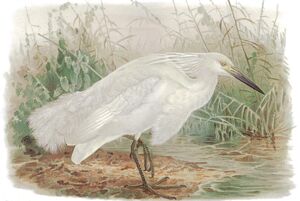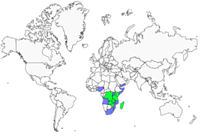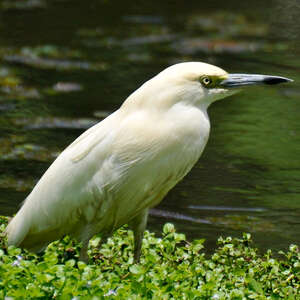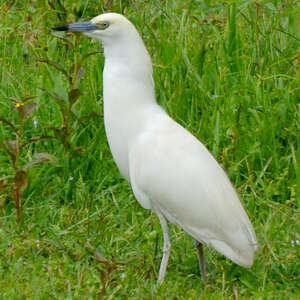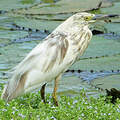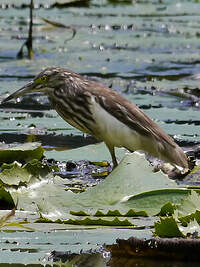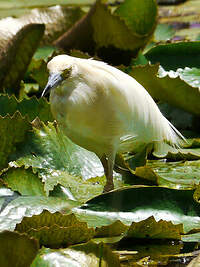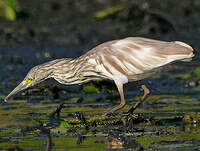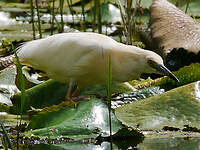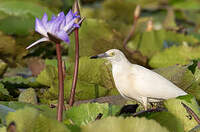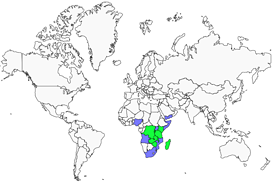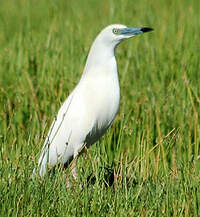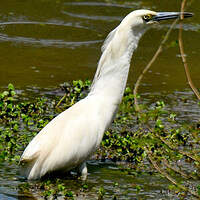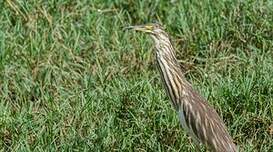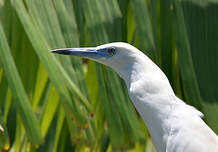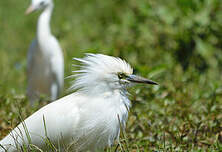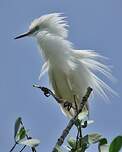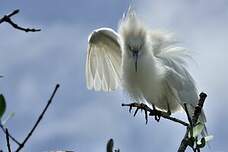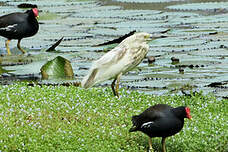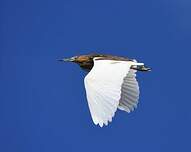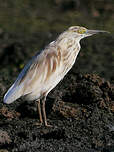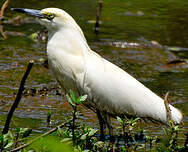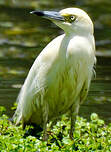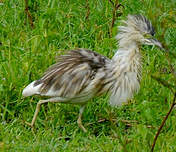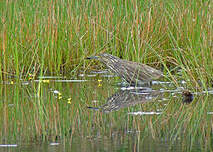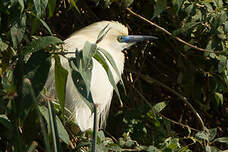Malagasy Pond Heron
Ardeola idae - Crabier blanc
Identification
The Malagasy Pond Heron is a small and stocky heron of the same size as the Cattle Egret, with which it can be easily confused. In breeding plumage this heron is all white with long feathers adorning its whole head down to the back of the neck, forming a long crest. It has ornamental feathers on its chest and on the scapulars which give it a fluffier, more vaporous plumage. The beak is bright blue with a black tip. The lores are yellow-green and blend in with an orbital area of the same colour. The iris is yellow. The legs are pink. In eclipse plumage, the feathers on the whole head are beige, striped with brown. The back, scapulars and rump are brown, striped with white and stand out in flight against the white wings. The small coverts may appear slightly brown. The chest is light yellow, striped with brown. The flanks, lower belly, undertails and retrices stay white even in eclipse plumage. The beak is greenish-grey with a black tip and the legs are greenish. There is no sexual dimorphism in this species. The juvenile looks very much like a non-breeding adult, but the tips of the wings are brown, the beaks are tending towards orange and also have a black tip.
Subspecific information monotypic species
Foreign names
- Crabier blanc,
- Garcilla malgache,
- papa-ratos-malgaxe,
- Dickschnabelreiher,
- kékcsőrű gém,
- Madagaskarralreiger,
- Sgarza del Madagascar,
- madagaskarrallhäger,
- Prydhegre,
- čaplička modrozobá,
- volavka modrozobá,
- Hvid Rishejre,
- valkorääkkähaikara,
- Malgassiese Ralreier,
- martinet ros de Madagascar,
- czapla malgaska,
- Мадагаскарская жёлтая цапля,
- マダガスカルカンムリサギ,
- 马岛池鹭,
- 馬達加斯加池鷺,
Voice song and cries
Habitat
The Malagasy Pond Heron lives in wetland areas of freshwater, surrounded by wooded areas that provide refuge from danger and in brackish waters. These wetlands are diverse, ranging from lakes, ponds, streams, ditches, shallow rivers, partially flooded or dry grassy meadows, and mangroves on Mayotte, Aldabra, and Europa. In Madagascar, the Malagasy Pond Heron is found from sea level up to 1800 meters. The Malagasy rice fields are also appreciated by the heron.
Behaviour character trait
The Malagasy Pond Heron is a solitary bird when feeding, but it is often observed in groups on shallow bodies of water where it fishes in ambush.
In Africa, rarely more than two individuals can be seen on the same body of water. During the breeding period, the Malagasy Pond Heron establishes heronries with other herons: Cattle Egrets and Little Egrets on Europa and Aldabra, Cattle Egrets on Mayotte. On Madagascar, it also mixes with the Crested Heron. It breeds from October to March. The heronries are hidden in healthy mangroves which usually provide protection and serenity, in bushes or scrubland but always close to water.Dietfeeding habits
Reproduction nesting
The nest is composed of intertwined twigs at a height of between two and six meters above sea level at high tide. The female lays two to four eggs, incubation lasts about three weeks and the feeding and monitoring of the young is for four weeks. That is fifty days from laying to the emancipation of the young Malagasy Pond Herons.
Geographic range
The Malagasy Pond Heron is endemic to Mayotte, Madagascar, Europa and Aldabra. It only reproduces in these 4 islands. The Malagasy individuals migrate to East and Central Africa (Kenya, Uganda, Democratic Republic of the Congo, Burundi, Rwanda, Tanzania, Zambia, Malawi, Mozambique, Zimbabwe and Nigeria) after nesting there to spend the southern winter. In Madagascar they are mainly found in the north and west, they are less frequent in the centre and east. In the Comoros they only nest in Mayotte where they are present year round. The species was regularly seen from 2004 onwards. In Aldabra its presence was not confirmed until 1967. In the 2000s, it is still present but rare. It is mainly found in the southeast of the atoll. The first sighting on Europa was in 1994 and small colonies were seen later.
Threats - protection
IUCN conservation status
concern
in the Wild
threatened
evaluated
The Malagasy Pond Heron is a species that is classified as critically endangered. This species is particularly studied and protected in Mayotte, where it represents 10% of the global population. The Mayotte Bird Study and Protection Group closely follows the reproduction through kayaking, ultralight aircrafts and drones. This new technology allows to discover new nesting sites on the island. Since 2010, a partnership action plan has been set up with various financial and technical partners (DEAL, Agence des Aires Marines Protégées). In 2015, the GEPOMAY established a National Action Plan for the Malagasy Pond Heron. Unfortunately, the still low number of nests are often poached (eggs and chicks looting), villagers not hesitating to destroy mangroves to reach the nests. To these poaching facts, climate change is added, and farming is also adapting their habitat, as well as competition with other herons on the nesting sites.
Sources of information
- IOC World Bird List (v14.1), Gill, F and D Donsker (Eds). 2023.
- Les Oiseaux de Mayotte, Clément Michel, Grissac Philippe, Rolland Robin
- The Birds of Africa Vol VIII : The Malagasy Region, Safford R. et Hawkins F.
- ARKive, Christopher Parsons
- GEPOMAY,
Other sources of interest
 Specification sheet created on
25/07/2023 by Nathalie Santa Maria
Specification sheet created on
25/07/2023 by Nathalie Santa MariaTranslation by AI Oiseaux.net
published: 30-01-2016 - Updated: 11-09-2016
© 1996-2024 Oiseaux.net
- Accipitriformes
- Aegotheliformes
- Anseriformes
- Apodiformes
- Apterygiformes
- Bucerotiformes
- Caprimulgiformes
- Cariamiformes
- Casuariiformes
- Charadriiformes
- Ciconiiformes
- Coliiformes
- Columbiformes
- Coraciiformes
- Cuculiformes
- Eurypygiformes
- Falconiformes
- Galliformes
- Gaviiformes
- Gruiformes
- Leptosomiformes
- Mesitornithiformes
- Musophagiformes
- Nyctibiiformes
- Opisthocomiformes
- Otidiformes
- Passeriformes
- Pelecaniformes
- Phaethontiformes
- Phoenicopteriformes
- Piciformes
- Podargiformes
- Podicipediformes
- Procellariiformes
- Psittaciformes
- Pterocliformes
- Rheiformes
- Sphenisciformes
- Steatornithiformes
- Strigiformes
- Struthioniformes
- Suliformes
- Tinamiformes
- Trogoniformes

